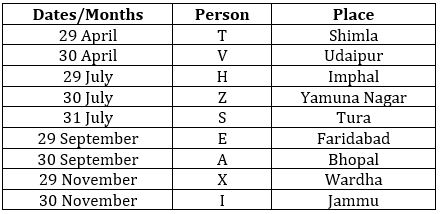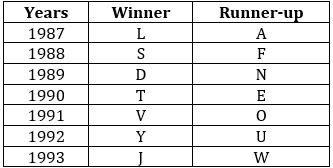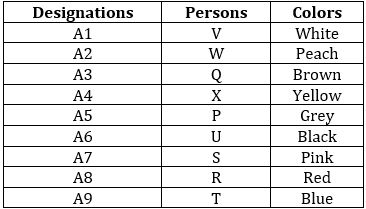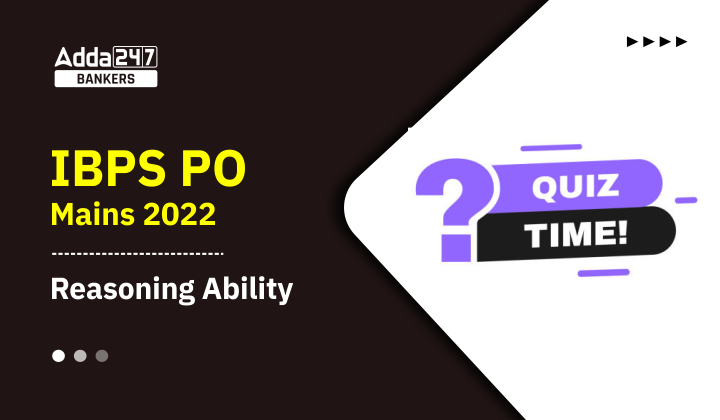Directions (1-5): Answer the questions based on the information given below.
Nine persons will attend a conference on 29, 30 and 31 of April, July, September, and November. No two persons will attend the conference on the same day or at the same place. The name of the city where a person will attend the conference is such that it starts with the preceding or succeeding letter of the name of that person. For example: If the person attending a conference is ‘P’, then his conference will be in a place whose name starts with ‘O’ or ‘Q’
The one who will attend the conference in Imphal has the conference in July but not on 31. Three persons will attend the conference in between V and E such that V has his conference before E. E and the one who has a conference in Bhopal have conferences in the same month. One of the conferences in April will be held in Udaipur. X and T have conferences on the same date of different months. The person who has the conference immediately after X has the conference in Jammu. A has the conference before X but not in the same month. The one who has the conference in Tura will attend it immediately before the one who has the conference in Faridabad. H and S have their conferences in the same month. Z will attend the conference immediately before S. I has his conference immediately after the one who has the conference in Wardha. The one who will attend the conference in Yamuna Nagar will do so on 30th July. The conference in Shimla is before November.
Q1. On which date is the conference in Shimla?
(a) 29th July
(b) 30th September
(c) 29th April
(d) 31st July
(e) None of these
Q2. Who has the conference on 31st July?
(a) The one who has conference in Shimla
(b) S
(c) The one who has conference in Faridabad
(d) I
(e) None of these
Q3. The one who has the conference in Tura will attend it in the same month as _______.
(a) The one who has conference in Jammu
(b) V
(c) The one who has conference in Faridabad
(d) Z
(e) None of these
Q4. Which of the following is correct?
I. Four persons have conferences after the one who has the conference in Tura.
II. T has his conference in Udaipur.
III. I has his conference immediately before H.
(a) Only I
(b) Only II and III
(c) Only I and III
(d) Only II
(e) None of these
Q5. If the conferences were attended in the alphabetical order of the attendees’ names from April to November, then who among the following would attend the conference in Bhopal in the new arrangement?
(a) V
(b) S
(c) X
(d) H
(e) T
Directions (6-10): Answer the questions based on the information given below.
In the year 1987 to 1993 (consecutively), an English competition was held which had one winner and one runner-up in each year. None of the persons whose names start with vowels were the winners. The persons whose names start with vowels received their awards in the alphabetical order of their names from 1987 to 1993 but not necessarily in consecutive years. None of the persons participated in more than one year
O and V won awards in the same year. Four English competitions were held after the year in which D participated. Two English competitions were held in between the ones in which F and O participated such that F participated before O in the same category. S was the winner of the competition in the year immediate before the one in which N was the runner-up. S and U did not participate in the same year. S was not the winner of the competition in 1987. Y won the competition in the year immediate before the one in which J was the winner. One year was in between the years in which Y and T were the participants. L participated in the year immediate before F participated. At least two years were in between the years in which A and W participated. E did not become the runner-up in the year 1988. U did not participate in the last year.
Q6. Who was the runner up in the year 1993?
(a) W
(b) S
(c) D
(d) N
(e) T
Q7. Who among the following participated in the same year as E?
(a) W
(b) Y
(c) J
(d) T
(e) None of these
Q8. In which year did Y win the competition?
(a) 1991
(b) 1987
(c) 1992
(d) 1988
(e) None of these
Q9. As many persons won the competition before L as many were runner-ups after ________.
(a) F
(b) N
(c) U
(d) W
(e) None of these
Q10. Which of the following is true?
I. Y won the competition in the immediate year before which W participated.
II. F was the runner-up in the year in which D won.
III. Three persons were runner-ups in between A and E.
(a) Only I
(b) Only II and III
(c) Only I and III
(d) Only II
(e) None of these
Directions (11-15): Answer the questions based on the information given below.
Nine persons (P, Q, R, S, T, U, V, W, and X) work in a company. Each of them has different designations (A1, A2, A3, A4, A5, A6, A7, A8, and A9) but not necessarily in the same order. All the designations are in descending order of precedence such that A1 is the senior most designation and A9 is the junior most designation. Each person likes different colors (Red, White, Yellow, Blue, Black, Peach, Brown, Grey and Pink).
Q is three designations senior to U. S who likes Pink is junior to U. P who is one designation junior to X is two designations senior to S. R who likes Red is senior to T. T is not A4. The person who likes Blue is three designations junior to the person who likes Black. The person who likes Grey is two designations junior to the person who likes Brown. Only V who likes White is senior to W. The person who likes Peach is two designations senior to X.
Q11. What is the designation of the person who likes Yellow?
(a) A3
(b) A2
(c) A6
(d) A4
(e) None of these
Q12. Which of the following combinations is/are not definitely correct?
(a) W- Peach
(b) P – Grey
(c) Q – Yellow
(d) T – Blue
(e) U – Black
Q13. P likes which of the following color?
(a) Brown
(b) Yellow
(c) Blue
(d) Black
(e) None of these
Q14. The person who likes Blue is how many designations junior to the person who likes Brown?
(a) Five
(b) Four
(c) Six
(d) Seven
(e) None of these
Q15. Who among the following is one designation senior to S?
(a) The person who likes Brown
(b) The person who likes Blue
(c) The person who likes Yellow
(d) The person, who likes Black
(e) None of the above
Solutions
Solution (1-5):
Sol.

S1. Ans. (c)
S2. Ans. (b)
S3. Ans. (d)
S4. Ans. (a)
S5. Ans. (a)
Solution (6-10):
Sol.

S6. Ans. (a)
S7. Ans. (d)
S8. Ans. (c)
S9. Ans. (d)
S10. Ans. (a)
Solution (11-15):
Sol.

S11. Ans. (d)
S12. Ans. (c)
S13. Ans. (e)
S14. Ans. (c)
S15. Ans. (d)





 GA Capsule for SBI Clerk Mains 2025, Dow...
GA Capsule for SBI Clerk Mains 2025, Dow...
 The Hindu Review October 2022: Download ...
The Hindu Review October 2022: Download ...
 ECGC PO Cut off 2025 Out, Check Final Cu...
ECGC PO Cut off 2025 Out, Check Final Cu...




